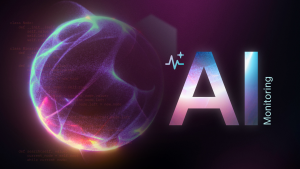
We published our State of Observability for Retail report, showcasing how leading retail organizations use observability to enhance digital customer experiences (DCX), and improve operational efficiency. The report, based on insights from 148 technologists and decision makers working in the retail industry, underscores the strategic importance of observability, with respondents reporting 4x return on investment (ROI).
“Retailers need to deliver great digital experiences to their customers, and they rely on observability to let them see into their digital presence," said New Relic Chief Technology Strategist Nic Benders. "The findings in the report clearly show how strategic investments in observability not only drive technological innovation, but also lead to tangible business outcomes, enhancing customer satisfaction and operational visibility.”
Retailers are minimizing downtime and optimizing customer journeys with observability
Retailers are using observability to deliver business value and gain a competitive edge. As retail organizations prepare for peak shopping periods like Black Friday and Cyber Monday, observability solutions like the New Relic Intelligent Observability Platform are helping them address key challenges, from minimizing downtime to optimizing online customer journeys. Retailers are also advancing artificial intelligence (AI) and the Internet of Things (IoT) to build resilience and streamline operations.
Retail and consumer organizations adopted alerts (62%) and network monitoring (59%) at higher rates than other industries, highlighting the demand for rapid, actionable insights in fast-paced retail environments. Retail organizations outpace other sectors in addressing outages, with a median mean- time- to -detection (MTTD) of just 32 minutes. This agility translates to a median annual downtime of 164 hours—41% lower than other industries surveyed in the wider 2024 Observability Forecast report.
Retailers plan to deploy browser, mobile, and synthetic monitoring to enhance digital experience
With billions in consumer spending shifting online, digital experience monitoring (DEM) has become a cornerstone of growth. DEM combines real user monitoring (RUM)—covering browser and mobile monitoring—with synthetic monitoring for proactive testing and improvement. Over half (52%) of the respondents said they planned to deploy synthetic monitoring within three years, 49% anticipated deploying mobile monitoring and 42% planned to implement browser monitoring to optimize online customer journeys.
Retailers are adopting Security, AI, and IoT to build resilience and streamline operations across their digital estate
Security, governance, risk, and compliance was the top technology strategy driving observability adoption, with 46% of retail organizations indicating this was the case. AI technologies are also a significant catalyst, with 39% of retail respondents identifying AI as a key driver for observability. This trend reflects the sector's commitment to leveraging AI for enhanced decision-making, customer insights, and operational efficiencies. In addition to AI, cost management (36%) and customer experience management (34%) are pivotal strategies shaping the observability landscape.
The integration of IoT technologies was another key factor, with 32% of retail organizations saying this was driving their desire to adopt observability. IoT can serve multiple functions in retailers, including inventory tracking and monitoring in-store sales personnel. This was higher than any sector except media and entertainment, highlighting retail’s proactive stance in harnessing IoT for operational excellence.
Retailers prefer a single, consolidated observability platform to connect IT performance data to business outcomes
In a push to enhance operational efficiency and drive business value, retail and consumer organizations have their sights set on achieving full-stack observability. While only 18% of organizations have reached this milestone, the sector is making strategic strides to overcome barriers like an overload of monitoring tools and siloed data, which 35% identified as major hurdles.
One such way they’re making this transition is through tool consolidation, with retail organizations now using 4.4 tools, down from 5.4 in 2023 and 5.9 in 2022, and outperforming the broader industry average of 4.5 tools. This proactive consolidation effort will support the shift to full-stack observability, with nearly half of the organizations surveyed planning to further streamline their observability investments within the next year to unlock greater operational efficiency and maximize ROI.
As retail organizations prioritize their observability strategies, the focus is on selecting platforms that offer comprehensive capabilities, affordability, and real-time linkage of business outcomes to telemetry data. With 41% favoring a single, integrated observability platform, the retail sector is poised to harness powerful, consolidated solutions that promise transformative impacts on business operations and customer experience. This strategic leap marks a significant step forward in driving the sector's competitive edge in an increasingly digital marketplace.
“Just as a carpenter has a suite of tools on hand to complete a job, running an effective ecommerce site requires that the right tools are used—it makes the team much more productive overall.” - Goran Stefkovski, Chief Technology Officer at Kogan
New Relic innovations empowering retail success
The New Relic Retail Solution bridges the gap between observability best practices and business outcomes for retailers and organizations with fully integrated, AI-strengthened observability that is tailored to retailers’ needs. Unlike fragmented alternatives, the platform allows retailers to enhance their omnichannel strategy with a comprehensive view of their complete retail journey across online applications, physical locations, and distribution centers. They can track customer journeys with a consolidated, real-time view of all systems and services across each stage of the business, and enhance performance and overall user experiences with real-time failure notifications and anomaly detection. Retailers can use our platform to proactively prevent disruptions, get to the root cause of issues faster and monitor all touchpoints to increase retention, engagement, and conversion while driving faster innovation and protecting revenue. Key capabilities include:
- Application performance monitoring (APM): Monitor the performance of ecommerce applications to identify issues that can affect user experience and transactions.
- DEM: Fully track and analyze digital user behavior and engagement end-to-end across web and mobile to ensure the best digital experience.
- Infrastructure monitoring: Get visibility into the health and performance of in-store systems, including servers and network devices supporting point of sale (POS) systems.
- Kubernetes monitoring: Get insights into containerized applications used in retail operations, ensuring efficient and scalable in-store services.
- IoT monitoring: Analyze in-store devices, such as sensors and smart shelves, to optimize in-store operations and customer experiences.
- Network performance monitoring: Understand if network performance is functioning optimally (crucial for POS transactions and in-store connectivity).
Next steps
- View the State of Observability for Retail report.
- Discover New Relic Retail Solution, New Relic for SAP, New Relic Pathpoint Plus
The views expressed on this blog are those of the author and do not necessarily reflect the views of New Relic. Any solutions offered by the author are environment-specific and not part of the commercial solutions or support offered by New Relic. Please join us exclusively at the Explorers Hub (discuss.newrelic.com) for questions and support related to this blog post. This blog may contain links to content on third-party sites. By providing such links, New Relic does not adopt, guarantee, approve or endorse the information, views or products available on such sites.



